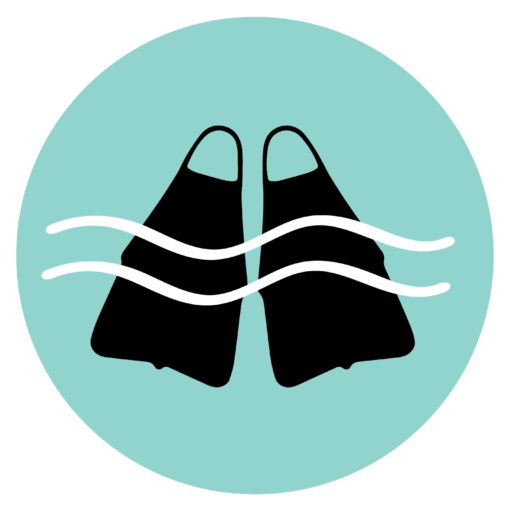Leading a healthy lifestyle has always been important to me. I eat clean, exercise regularly, meditate occasionally, and average eight hours of sleep per night. I also surf or bodysurf for at least an hour on most days.
But there was a chapter in my life when this was not the case; I was not healthy.
During this time I suffered a two-month stretch of insomnia—a result of seasonal depression—which caused a marked decline in my mental and physical health.
I experienced such crippling anxiety that I lost the ability to breathe rhythmically. My upper back and neck were in constant pain. Worst of all, I was only able to focus on simple tasks for minutes at a time.
I woke up every morning thinking, “What’s wrong with me? Will I ever feel normal again?”
Years later, I am happy to report that I do indeed feel normal again (thank goodness). But to what do I owe my improved health?
In a word, bodysurfing.
Bodysurfing is great exercise.
“A great deal of publicity has been given to Hawaiian swimmers riding waves with surfboards,” said Olympic swimmer Wally O’Connor, who won a gold medal for the United States in the 1924 Summer Olympics. “Without a doubt it is a great sport, but in my estimation it cannot compare with the thrills, pleasure, and exercise of bodysurfing.”
I absolutely agree with O’Connor on this point: although surfing is great exercise, it is no match for bodysurfing. Surfers can float on their surfboards when they need to rest. But bodysurfers must tread water the entire time they are immersed in the ocean.
Bodysurfing benefits our health primarily through the act of swimming. “To derive the most pleasure from riding large waves,” wrote Ron Drummond in The Art of Wave Riding, “an all around knowledge of swimming is essential. A powerful stroke, good endurance, and the absence of fear are the primary requisites.”
Swimming in the ocean provides a pleasurable full body workout that improves our breathing and mindfulness. Best of all, swimming is a low-impact exercise that we can do daily into old age.
“People report enjoying water-based exercise more than exercising on land,” states the Center for Disease Control and Prevention (CDC). “They can also exercise longer in water than on land without increased effort or joint or muscle pain.”
Many scientific studies have revealed the health benefits of swimming, which include greater lung capacity, better breath control, improved core strength and posture, enhanced mood, reduced anxiety, and decreased risk of chronic illness.
And here’s the kicker: “Swimmers have about half the risk of death compared with inactive people,” says the CDC. You have to like those odds!
Our bodies are adapted to survive in the ocean.
One of the great things about swimming is that we are born to do it. Put an infant in a pool (with parental supervision, of course) and they will instinctively start swimming. In fact, most human babies demonstrate an innate swimming reflex from birth until roughly six months old.
“Each of us begins life floating in amniotic fluid that holds a 99% similar chemical composition to seawater,” writes journalist James Nestor. “Our earliest characteristics are fishlike. Human blood has a chemical composition 98% similar to seawater.”
Evidently humans are born of the ocean, an idea supported by our mammalian dive reflex. This innate reflex, also known as the Master Switch of Life, kicks in the moment we bodysurfers dive into the sea. Our physiologies adapt to the aquatic environment by slowing our heart rates 25% and redistributing oxygen to the heart and brain.
Essentially, we become more dolphin-like upon entering the ocean, improving our physical health in the process. No wonder I often leave the ocean feeling transformed after a bodysurf session!
But it is not just our physical bodies that are transformed during ocean play, it is also our minds.
Bodysurfing benefits our mental health.
Exercise is great for our mental health; so is meditation. Bodysurfing—like yoga, martial arts, and swimming—is a combination of both.
In essence, bodysurfing is meditative physical exercise in the ocean, and exercise is a natural antidepressant. Strenuous physical activities like bodysurfing stimulate the release of endorphins (feel-good neurochemicals) that simply make us feel better. Movement is medicine.
In addition, bodysurfing provides us with a unique form of nature therapy. “We are most alive and at ease in the wilderness and among the myriad other species teeming there,” says Thad Ziolkowski, author of The Drop. “Ocean and forest and mountain are where our ancestors spent the vast preponderance of evolutionary time—three million years versus the very recent historical past of the agrarian era.”

“To be near or in a body of water—stream, lake, ocean, even swimming pool—induces a pleasant, meditative state,” Ziolkowski adds. “Again, as a consequence of ancestral life, in this case of our having been so preoccupied with finding sources of water that simply to be in water’s presence soothes and reassures, allowing our thoughts to drift, to turn to matters other than whether we have enough to drink and thus to survive.”
Clearly, the ocean plays a vital role in our lives on this blue planet. And what better way to tap into the ocean’s healing power than bodysurfing? It certainly worked for me.


